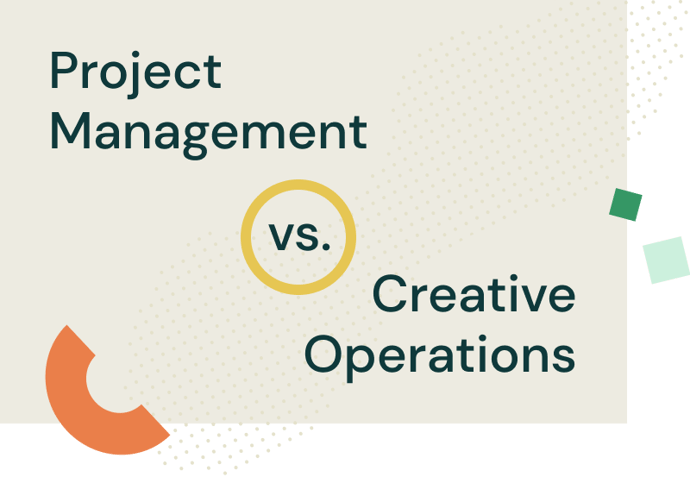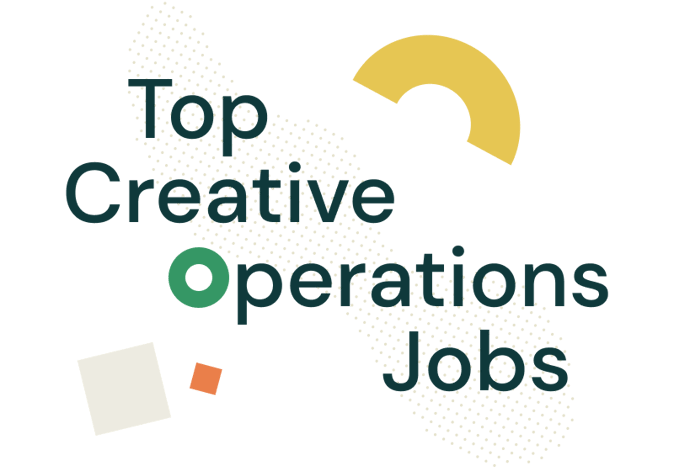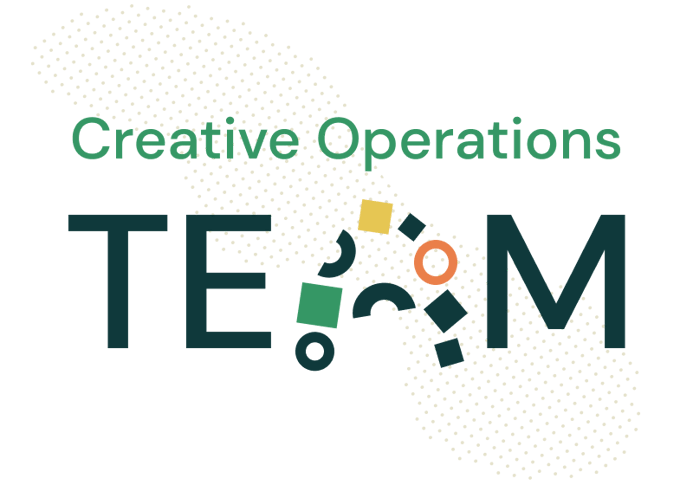The Important Role of Creative Operations Manager in eCommerce
In eCommerce photo studios, for as much as there’s always content to create, there are just as...
Welcome to the wonderful world of creative ops! Below, you'll find a comprehensive and (most likely) ever-growing guide. For now, grab a cup of coffee (or your drink of choice), and let's put the pieces of this puzzle together.
There are a LOT of definitions online about creative ops, and to be honest, they're all right... and wrong. Let us explain.
No matter what field you work in, there are creative ops of some kind, even if it's not defined as such. That being said, there are two schools of thought when it comes to our beloved creative operations; people and process. This means, if you only define creative ops in one of the two ways, you're leaving out half the definition.
We've broken our definition down into 3 pieces; people, process, and overarching. Without further adieu, the CreativeOperations.com definition of creative operations!
The creative and account teams who work together to constantly pressure test how a creative project works best to deliver an assignment.
The process or structure in which a creative team works to deliver a project.
A constantly evolving production system that uses technology to remove pain points in a project with the goal of allowing creatives to be creative while delivering what stakeholders requested on time.
So moving forward, don't forget that creative operations has two distinct schools of thought, but there is an overarching definition that can include both.
We talked to Faye Garland, the Head of Retouch and Image Management at THG Studios, and in photo studios, she had some thoughts about defining creative operations and how the creative process is different for parts within her studio.
Each studio will have particular elements in its process that are reflective of its product and client base, so there’s no one-size-fits-all approach to operations. In fact, operations should be built to flex, mold, and evolve around their team's output.
Some creative teams may experience more frequent adaptation. Take design/artwork vs. photographic departments as an example. Photographic processes can change dramatically depending on the type of brief. A large-scale shoot such as an interiors project may require alterations to your existing process to include more specialisms, touchpoints, and subject matter experts. Whereas design and artwork can remain fairly consistent."
- Faye Garland, Group Head of Retouch and Image Management at THG Studios

 Chapter 2: Project Management vs. Creative Operations
Chapter 2: Project Management vs. Creative Operations
Across the internet, people are defining creative operations as, "Project Management for Creative." And again, it's not wrong, but it's not right. The biggest difference between the two is understanding the creative process.
With project management, the team has guidelines, operations, and most likely, specific deadlines to meet. A project manager, in this case, would guide the team to make sure that all of these guidelines, operations, etc. are followed, within budget, and delivered on time.
In creative operations, the exact same things are needed, except for one additional component, understanding. Time and time again, we hear that the best creative ops leaders are those that have previously been creatives. They come to the tasks with an understanding of the overall creative process, how conceivable it is to be delivered in X days/weeks/months, and emotional intelligence about the team doing the work.
A great project manager can guide a team to success by knowing what needs to get done and when it needs to be completed. Great creative operations managers must do this as well as understand the connections between creative teams, how they work together, the emotional toll that creative teams go through, and finally, a strategic mindset to find better ways to do it all, from ideation to delivery.


Below we'll dive into the specific jobs, but Briah Michel, in Creative Operations at Wieden + Kennedy made an incredible point recently;
The most important job in Creative Ops is a tie between organization and being a team player. We're here to keep everyone in sync and with the goal in mind of accomplishing what we're here to do - make amazing work. It's cliche but there really is no "i" in team. We all have a part to play in making things happen and it's our job to make sure we all do it together. Being organized is 1000% needed. We can all get carried with things but when it's crunch time, staying on top of things make everything go so much smoother for not just us, but our entire teams/accounts.
- Briah Michel, Creative Operations at Wieden + Kennedy
This section could be continuously updated and edited for the unforeseeable future. So for right now, we'll just list the five most well-known creative operations positions available.
Head of Creative Operations
Director of Creative Operations
Creative Operations Specialist
Creative Operations Coordinator
And remember, just because it's not on the list above, does not mean it's not in creative ops, and just because it doesn't have "creative operations" in the title, doesn't mean it's not in creative operations. You could include the entire creative team from Creative Directors and Art Directors to Designers, Copywriters, and Photo Editors in this list if you wanted. And operations. And strategy. Honestly, c-ops goes much deeper than most people realize.


A more appropriate question might be, what industries don't?
Here's where things get interesting.
From photo studios to financial services, every industry has an opportunity to use creative operations. It all comes down to what creative work needs to be accomplished and how you define creative assets.
Here are a few industries and how they use creative operations.
Marketing
From planning to ideation, creative brief, brainstorming, first drafts, and approval processes, this is an obvious connection to creative operations. Most things being done in marketing should run through a creative operations team.
Manufacturing
When many people think of manufacturing, they don't associate what they do with being a "creative process," but the second you consider design, proofing, and the reviews involved in everything that is made these days, you see just how much of it can benefit from a c-ops mindset.
Photography
Picture a photography studio in your head. Now imagine it filled to the brim with people running back and forth, pieces of clothing and models strewn everywhere, and someone, somewhere, has the shot list, while someone else has the style guide. Without a solid creative operations team, time is wasted, shots are missed, reshoots are imminent, and all editing, reviews, and deliveries are slowed down. Creative ops thrive in the studio space.
Retail
Both the physical and eCommerce customer experience is reliant on the creative operations team working together to build it all out. From how products are designed to how those same products are situated on the shelves, it all takes a team to plan it out and deliver it on time.
Farming
This example is out there for a reason. How could creative operations possibly be used in farming you ask? Consider planning from ideation to delivery...
What crop should we grow?
What's the best ROI for crops?
What location will be the best for the crop?
What seasons does it grow in?
Can we grow more than one crop?
Can we store it?
Who will move it?
What stores will carry it?
How will we transport it?
Who will transport it?
As you can see, even something that doesn't sound like creative operations could flourish from it. Every step of the journey from thought to delivery can be helped with a creative team working together to deliver and continuously improve the delivery of the creative... or crop.


To really understand the necessity of creative operations, you need to understand what is involved in a creative ask.
For our example, we'll use a photo studio. When you read through this very simplified version, you can quickly see how something evolves into a massive undertaking with an entire organization involved.
I see creative operations as enablers, making the creative process within a business more structured. Enabling employees to move faster and create ‘better’ work.
- Victoria Rose, Senior Content Producer at Henry Stewart Events
Photo Studio Manager
Photographer
Production Coordinator
Stylist
Makeup and Wardrobe
Models
Photo Assistant
Lighting Tech
Photo Editor
Director
Shipping and Receiving
Building the creative brief
Planning the shoot
Setting the stage in the studio
Hiring Models
Receiving products
Prepping products
Styling products
Hair
Makeup
Lighting
Will food be served?
Getting the shot required
Review and approval 1
Sending photos for post-production editing
Review and approval 2
Sending to client
Receiving approval for the final photo
Paying staff involved
And this is for ONE photo, imagine thousands.
Creative operations is the way to coordinate the entire creative workflow to be completed, with all of the people involved, and deliver the exact creative work that the client requested, by the due date.
Creative ops give the creative team a shortcut to success. It makes every piece of the creative process easier than without.


Before we get to actually building a creative operations team, let's talk about the first hire for that team, the Creative Ops Manager. This unicorn of a person will transform your creative team and workflow. And the best of them will have the following skills (or some version of them).
Organization
Anticipation of needs
Resourcing/hiring experience
Ability to prioritize work
Embraces the small things
Hand-holding
Production insight
Strategic insight
Accurate project forecasts
Manages deadlines
Previously a creative
Empathy
And while not a skill per se, the Creative Ops Manager is not a silo (we'll talk more about this later), they are EMBEDDED in the team. So many teams split the creative ops manager away to rule on high when they should be right in the middle of the creative workflow. Seeing the supply chain first hand.
The reason they are in the position that they're in is to be a part of implementing creative operations across everything. All creative projects should have a manager overseeing them.


Your creative operations team is yours and yours alone. In the same way that there's no perfect definition, there's no perfect creative ops team structure. That doesn't mean there aren't things that you can do to make the transition from nothing to something easier.
So, starting from scratch. If you want to do it the easiest way possible, your first hire is the unicorn from above, a creative operations manager with experience in both the creative AND operations side of things.
That "with experience," is important because, at the end of the day, creative operations is all about people and processes. The best managers have experience in both.
That being said, let's go through a checklist of things needed to build or transform your team into a lean, mean, creative operations machine.
To implement creative ops, you obviously need a team, but make sure that your team is one that has both a creative mindset and the ability to follow processes. It's important for a creative team to understand that it is a team, and to do the best work, the most efficiently, they can't forget that the creative processes are in place for a reason.
Creative operations is also a process, so everyone involved from ideation to delivery has to be a part of that process or at least the planning for the creative processes. This all means that the plan moving forward on any creative ops team is followed, tested, and evolves as a team. Egos are checked at the door and they all work together to build the best and most efficient delivery system they can.
When beginning to mold creative workers into a creative ops team or building a team, remember that it all comes down to testing. Test what works, and what doesn't work, and use it to create the outcome you want.
Be. Prepared. For. Things. To. Not. Work.
This phase is constant and forever. If some creative briefs don't work, that's okay, just make sure you're constantly gathering data. Testing is to develop the processes that work and let go of the ones that slow you down or flat out don't work. It's okay to fail as long as you learn from it.
As you test different processes and people, know that your team will evolve. And know, that if you aren't constantly evolving, you'll be left behind. The best piece of advice we can give to any team transitioning to creative ops or building their team is that the processes you have today, should not be the same as they are in a year... six months. Constant evolution is important.
This isn't a typo, it's to make a point. Make sure you're on the same page with your team and keep evolving.
Building a creative operations team after roles have been established will take a lot of work because we're creatures of habit and when you implement creative ops, things will change. As long as everyone understands that it's for the betterment of the team, the betterment of the company, and a way to make everyone's work life less stressful, it's easier to let go of existing processes. Allow time for the transition.

.png?width=739&height=517&name=Team%20Structure%20(1).png) *Generalized and combined org chart to show C-Level, Head of Creative Ops, and Director Level
*Generalized and combined org chart to show C-Level, Head of Creative Ops, and Director LevelThe biggest suggestion we have in regard to team structure is to make sure to avoid silos. They're teams for a reason and they need to be a cohesive unit.
In a lot of ways, the Head/Director of Creative Operations is the brain of it all. The account director manages the account team, the creative director manages the creative team, and the head of creative operations manages... every team.
That being said, it's not the same for everyone.
Barring last-minute creative deadlines, it's important that the current creative workflow connects the team and never pushes them apart. How different industries build their team structure depends on multiple channels and the project's deliverables. The structure will be decided by what works best for your specific creative work. Continuously dissecting processes and tweaking workflows for efficiency will allow you to build the team you need.
Your team and another team doing the same type of work might look very different depending on the specifics of the project they're delivering.

.png?width=701&height=491&name=Why%20is%20Creative%20Operations%20Important_%20(1).png)
If you've read everything above and you haven't put together why creative operations teams are important, we've laid out the 5 most straightforward reasons.
To implement creative operations, you have to remember that it's incredibly collaborative. From ideation to delivery, everyone is involved in building the most efficient team possible. This means that everyone WANTS to work together to find ways to make things better. The team is never pointing the finger, only focusing on ways to do things better as a team.
As far as business decisions go, creative ops solve a lot of the waste issues, from money to hours to resources. No matter what your creative team produces, there will be less waste and a quicker approval process with a solid c-ops team in place. Good project briefs will also always help here.
Is there nothing more delicious than this phrase?
One of the best parts of having a team so connected is bringing data into the mix. This means collecting data from the start and after delivery for everything from budget to timing to the approval rate of past projects. Bringing this kind of data to future conversations will not only be impressive, but it will give the reasoning for any requests, from new hiring to new equipment. Key decision-makers will always prefer hearing that your team is managing projects with specific numbers rather than guesses.
With the data brought in above, you'll also have the numbers at your fingertips for planning and projecting in the future. And of course, if you know how long something took last week or last year, you'll have the information you need to plan for a similar project in the future. Meaning, the approval process for creative projects becomes quicker and the projects are completed in a timely manner!
This might be an odd way to say it but hear us out. Creative operations is built in such a way that most of the planning is done twice, to make sure that you only cut once.
From the first ideation to the final product, everyone is involved in planning and the team works together, instead of against each other, to deliver exactly what was asked. It's a beautiful system of checks and balances.
Creative ops is the magic behind the scenes. It’s a pretty vital role in our organization that helps us move faster and produce better work. To put it simply, it’s what all creatives need to thrive and focus on doing what they do best.
-Pernille Strøm Lundsfryd, Creative Director & People Lead at Accenture Song DK


So now that we know what creative operations is, how it's different from project management, what jobs are involved, how to build the team, what industries use it, and why it's important, what's next?
Many of us here at CreativeOperations.com feel that things are about to change in c-ops. The teams that are agile and have embraced the creative workflows that are a part of creative operations are going to be the ones that flourish. This past was only a warm-up.
It feels like we’re at the cusp of a seismic shift in eCommerce. For years we’ve been flirting with next-gen assets, starting with 360 spins which enabled product scans that could be turned into AR content (think “see this in your living room”).
These assets had scattered adoption and ROI was unclear, many early adopters scaled back their investment in these areas. But now technology is catching up, and consumers’ sensibilities have shifted. It’s hard to say exactly what the future of eComm is, but it will almost certainly include creative that is some mix of traditional media like photo and video, alongside interactive 3D, AR, and probably some form of generative AI.
The best evidence of this is to look at the technology that powers not just the creation of assets, but the infrastructure to support them. Companies like VNTANA have created a platform that assists in the optimization and distribution of 3D assets, and companies are using that tech today in both internal applications, like product design and review, and external applications like interactive 3D on product detail pages.
- Daniel Jesper, Chief Evangelist at Creative Force
And, while creative operations has been around for decades (in some form or another), it's still in an emerging category. Now is the time to start preparing and automating as much as possible for the future of eCommerce because it's coming if you're ready or not.
More consumer expectations mean more client expectations for more creative assets for more channels, at lower prices, and they want it faster than it has ever been delivered before. Will your marketing departments be ready?
The teams that not only allow technology to be a part of their plan but search it out, are going to be able to do the most work, the most efficiently. Period.
And the demand for creative assets will only grow. Your creative department and marketing teams need to be armed with the digital tools they need to handle it. Below you'll find a few things to look into to prepare for future growth's production demands. And don't worry, we'll have pieces about each of the topics below in the future.
Why will companies struggle in the future? Simply put, not being able to stay creative at scale. The future of creative ops is dependent on creative projects having help from things like:
With a digital asset management system, teams can store all of the brand’s creative assets (and more) in one place, so that they don’t have to compete with “sources of truth” when it comes to determining the most current and compliant version of a needed file. It’s a one-stop repository for images, videos, audio files, PDFs, and pretty much any other digital asset imaginable.
According to a 2020 Markets and Markets report, the digital asset management market size is slated to grow from $3.4 billion (USD) in 2020 to $6 billion by 2025.
The handling of a product (or multiple products) from inception, through design and engineering, to sales, service, and retirement. There are many definitions of this lifecycle, but today let's focus on the highest level, which includes; introduction, growth, maturity, and decline. When you break it down like this, you can see how this type of system could be used in almost any industry out there.
The key elements of project management software are to connect the team and resources, plan out tasks, manage deadlines, and in most instances, take the complex processes from the creative team to simplify them in one place. Most if not all of your existing creative workflows can be built out in project management software.
We're not talking about anything in the sky, these are the servers that team members can access over the internet and the software that runs on those servers. It's a way to collaborate with the team on multiple projects, from anywhere in the world. We're sure you're already using this, but it's important.
AI will continue to be more and more critical. Many teams are using it to bypass review and approval needs for visual components of projects and digital assets. It's usually built into another program that the creative team members use to simplify tedious tasks. The better it gets, the fewer team members and additional resources will be needed to complete creative processes.
Automation is simply reducing the need for human intervention across processes. Which makes things faster, reduces the possibility of error, and also reduces process inefficiencies by simply removing steps. Simply stated, the more you can automate, the less you have to do.
These are only a few over-arching thoughts on the future, but many of them can be implemented today by your creative team. It's time to start making data-driven decisions for the future and say goodbye to missed deadlines.
Question mark? As we've discussed, creative ops is a relatively new field. Over the next few years, it will no doubt ebb and flow with new guidelines, definitions, and ways to do things. CreativeOperations.com will be there to help you through it all.
If you'd like to discuss anything you've read there or are interested in contributing to the site, we'd love to continue the discussion! Feel free to reach out on LinkedIn.
In eCommerce photo studios, for as much as there’s always content to create, there are just as...
Want to get notified when we have fresh, new content ready for you?
Become a member of our community - it's free and you can unsubscribe anytime you want.
By signing up, you agree to receive emails from Creative Force and Creative Operations.